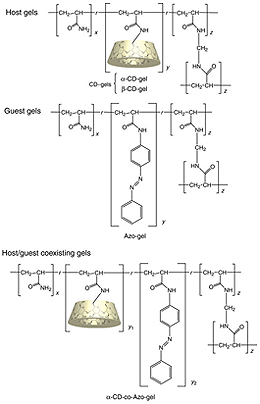Research Abstract
分子認識により光スイッチできるゲルの集積
Photoswitchable gel assembly based on molecular recognition
2012年1月3日 Nature Communications 3 : 603 doi: 10.1038/ncomms1617

ボトムアッププロセスとトップダウンプロセスを効果的かつ正確に橋渡しすることが、自己集合材料を開発するうえで重要である。分子認識による自己集合は、機能性材料を創製する強力な手段である。光応答性分子認識系を用いれば、光で制御される巨視的自己集合体を形成できる。今回我々は、2種類のホスト分子に対して異なる相互作用をするアゾベンゼン部分の光異性化によって、巨視的なゲル集積をうまく制御できることを実証している。ここでは、アゾベンゼン(ゲスト)またはシクロデキストリン(ホスト)で修飾されたポリアクリルアミドのヒドロゲルを用いて、光制御型ゲル集積系を開発している。この系は、光照射によってホストゲルとゲストゲルの可逆的な接着・解離を制御できる。また、トランス-アゾベンゼンとシス-アゾベンゼンに対するα-シクロデキストリンまたはβ-シクロデキストリンの親和性の違いを利用して、光で接着する相手が入れ替わるゲル集積系を構築できる。
- 大阪大学大学院 理学研究科 高分子科学専攻
- 科学技術振興機構(JST)戦略的創造研究推進事業(CREST)
The formation of effective and precise linkages in bottom-up or top-down processes is important for the development of self-assembled materials. Self-assembly through molecular recognition events is a powerful tool for producing functionalized materials. Photoresponsive molecular recognition systems can permit the creation of photoregulated self-assembled macroscopic objects. Here we demonstrate that macroscopic gel assembly can be highly regulated through photoisomerization of an azobenzene moiety that interacts differently with two host molecules. A photoregulated gel assembly system is developed using polyacrylamide-based hydrogels functionalized with azobenzene (guest) or cyclodextrin (host) moieties. Reversible adhesion and dissociation of the host gel from the guest gel may be controlled by photoirradiation. The differential affinities of α-cyclodextrin or β-cyclodextrin for the trans-azobenzene and cis-azobenzene are employed in the construction of a photoswitchable gel assembly system.

